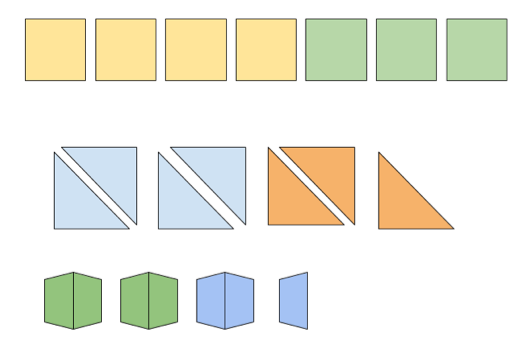My “A-ha” Moment:
Lost Opportunity to be a Math Genius
A girl in the “traditional” math program shared this insight with Joe Boaler who was conducting a research at this girl’s school:
We knew how to do it. But we didn’t know why we were doing it and we didn’t know how we got around to doing it . . . . [W]e knew what the answer was, but we didn’t really know why or how we went around doing it [using the given formulas]. We just plugged into it. And I think that’s what I really struggled with – I can get the answer, I just don’t understand why. (p. 136)
Travel back 25 years and there I was in a Grade 2 or Grade 3 math class in Japan pulling my hair out, utterly lost and confused. My enemy? Fractions. The source of confusion? Exactly what the girl told Jo Boaler.
So it went down like this:


Teacher: You have an apple. You would like to share this apple with 3 of your friends. So you cut the apple into quarters. When you distribute all the pieces to your friends, you will each have a ¼ of an apple.
Me: Okay, it sounds reasonable enough. Let’s think about this. I have 1 apple at the beginning and I divide this apple 4 ways. We will each have a piece of it. This is called one fourths. Wait, I am not okay with this. I still see the number 4, not ¼. The size and the shape of each 1 are different for sure but 1 is 1 and I have 4 pieces. Why don’t I just say I have 4 pieces instead of 1 apple?
Now I understand that the teacher had neglected to mention two crucial points – I, as a manipulator of numbers, can arbitrarily assign what should be considered “the whole” and represent the relationship between “the whole” and other parts within the whole. In other words, fractions are about multiple representations of relationships. I really needed to hear these words 25 years ago and to understand that mathematical representation can be contextual and I can manipulate numbers and patterns depending on the context of the problem I am working on.
In comparison, below is a recreation of some of the representations of 3/7 that Grade 7 students worked out using manipulatives in a math class at the school where I am doing my Community Service Learning:

Students were encouraged to work out at least 2 representations using different manipulatives or different mediums. When students were asked to share their representations with the class, they explained their representations using words such as “whole”, “equal units”, and “3 out of 7”. Students saw that their classmates came up with representations that were quite different from their own and thus, the idea that all of these representations were different expressions of the same fraction was reiterated.
It was quite magical when the students moved on to work out a few different representations of 2/10 and some of the students started to grasp the idea – without prior knowledge of the terminology and the concept of “equivalent fractions” – that there seemed to a connection between 2/10 and 1/5. I am looking forward to observing how these students will progress from here.

Reference:
Boaler, Jo. (2015) What’s Math Got To Do With It? (Rev. ed.). New York, NY: Penguin Books.